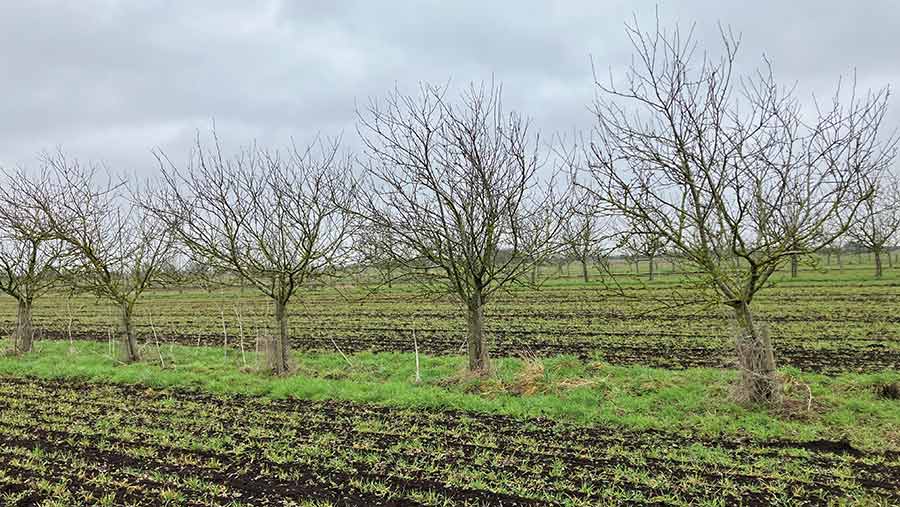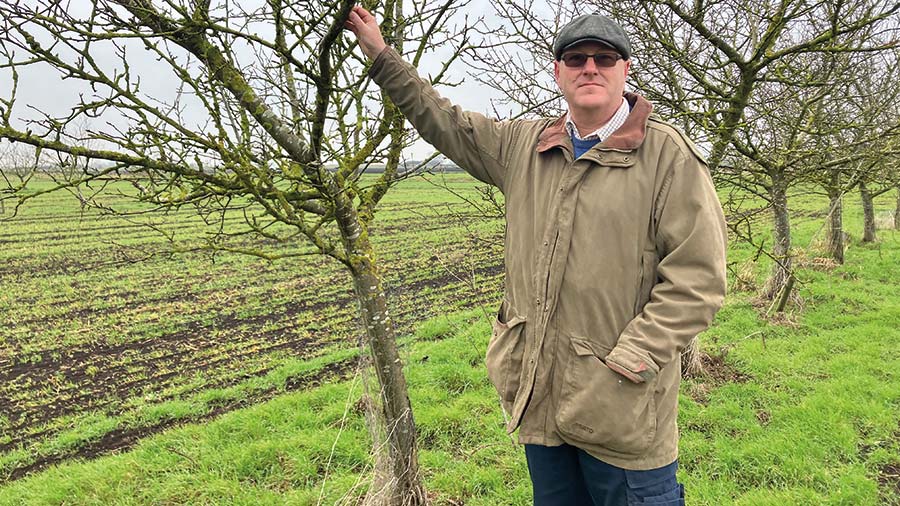Agroforestry: Can it work for farming as well as environment?
 © MAG/Emma Gillbard
© MAG/Emma Gillbard Agroforestry is attracting a lot of attention from policy makers, environmentalists and farmers seeking new opportunities.
Environmentally, the benefits are well recorded.
The Woodland Trust’s Farming for the Future report found that over a 30-year period, silvoarable systems can sequester the equivalent of 8t of carbon dioxide/ha/year, which is equivalent to the average annual carbon footprint of a UK household.
The charity estimates that establishing silvo-pastoral agroforestry on 30% of the UK’s grassland would achieve net-zero targets for the grassland sector by 2050, with a net sequestration rate of 21m tonnes of carbon dioxide/year by 2062.
But despite high levels of interest and growing records of the benefits, the Woodland Trust says only 3.3% of the UK’s agricultural area is under agroforestry.
See also: Analysis: Time for a closer look as SFI opens for business
Food production and sustainability
When it comes to food production and agroforestry, Jeremy Evans, outreach adviser for the Woodland Trust, says there is no single answer.
“It is not going to be the same across all landscapes, farms or systems,” he said. “Some of the benefits aren’t entirely tangible or monetary.
“It is a hell of a leap of faith, but as we work with more and more farmers, it is all building up and will hopefully become mainstream. It hasn’t been for everyone, but I think it’s building that way.”
Speaking broadly of the economic benefits, Jeremy explains:
“At the minute, you can’t cost the environmental benefits that agroforestry can bring in terms of soil, water, air and habitat quality.
“What you are gaining is future resilience and that sustainability effect on your farm.
“In a lot of agroforestry schemes there might be a reduction in food production, but this is slight, and the benefits are all of the other things trees can deliver.
“If it works really well, like in the case of Stephen [Briggs] (see case study below), then you’re quid’s in all the way.
“In a worst case, you should not be that much out of pocket, and you’ve got greater resilience in your farming system which increases sustainability.”
Government funding holds the key to wider uptake
The general consensus is that, nationally, a lack of government support is likely to be behind the slow uptake of agroforestry.
While the Woodland Trust offers a “Trees for Farms” grant, which in some cases sponsors up to 100% of the cost for an agroforestry system, competition is high and places limited.
But with the launch of the Sustainable Farming Incentive (SFI), funding for agroforestry is expected to be announced next spring.
“We heard at the Agroforestry Show that the stewardship schemes are bringing out agroforestry funding,” says Jeremy Evans from the Woodland Trust.
“We think this will sit under SFI and will definitely be about in-field agroforestry – so not the boundary systems, hedges and edges and shelter belts, but silvopasture or silvoarable systems,” he explains.
“The Forestry Commission is very confident that this scheme is coming on board next year, and I hope it comes through on this promise.”
Case study: Farming with trees

Stephen Briggs © MAG/Emma Gillbard
Having established the UK’s largest agroforestry system on his farm in Cambridgeshire, first-generation farmer Stephen Briggs has integrated fruit trees into his arable cropping system.
Asked how agroforestry supports an economically viable farming business, he says:
“We have to look at the bigger picture. The farming model that we have today, whether that be livestock-focused or crop production, is largely a specialised high-input, high-output model.
“This has obviously served a lot of people very well for many decades.
“Going forward, with the challenges of climate instability and extremes of temperature, we have to ask whether our farming models are fit for purpose.”
Planting 4,500 fruit trees more than a decade ago, Stephen says it was an investment in the farm’s future.
“In terms of profitability and economic stability, we are entering a period of history where we need to adapt our farming models to something with more resilience to be able to remain profitable.
“Yes, being profitable today is important, but we need to put measures in place now to make sure we are profitable tomorrow.”
Taking 52ha of land, Stephen planted the 4,500 fruit trees across the landscape at a density of 80 trees/ha in lines spaced 27m apart, leaving a 24m alley to grow cereal crops in.
“That results in 8% of the land area occupied by a perennial fruit tree crop, and 92% doing exactly what it was before,” he says.
“The single biggest input to all of our farming systems is sunshine,” Stephen explains. “We all harvest the sunlight, so as an arable farmer I recognise that a seed starting each year is quite risky.
“You wouldn’t have solar panels on the roof and turn them off from 1 July to 1 October. But that’s exactly what we do with cropping.
Business resilience
“So, from an economic perspective, I have to make the environment in which my business operates as resilient as possible to the challenges that come over the hill.
“All we’ve done with our agroforestry model is to try to build in some climate resilience by having a mix of annuals and perennials.”
Having funded the system himself, Stephen says he saw an economic return on the investment within eight years.
“As a tenant, we needed an economic return within the term of our tenancy, so now, when the fruit trees yield, we can add value,” he explains.
As well as the added income from the fruit trees, Stephen says the agroforestry system has also given a boost to his arable crops.
“We’re now finding, 15 years in, that those perennial rooting structures are helping improve drainage in the winter, and in the summer we’re getting less water loss and less crop stress.
“We are seeing more crop at the edges of the field, and actually getting a yield lift. That’s because the subterranean beneficial soil fungi such as mycorrhizas are more present.”
